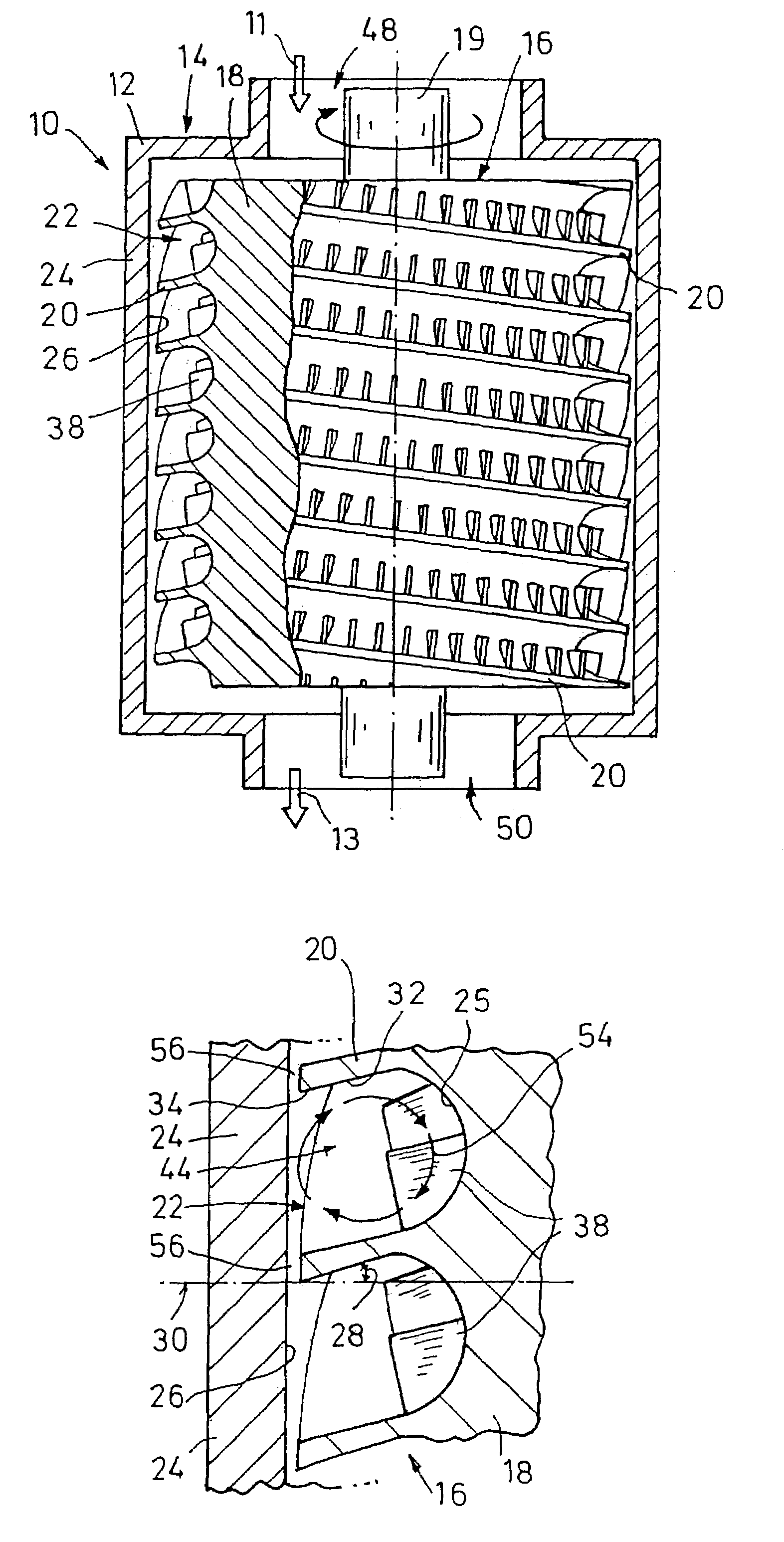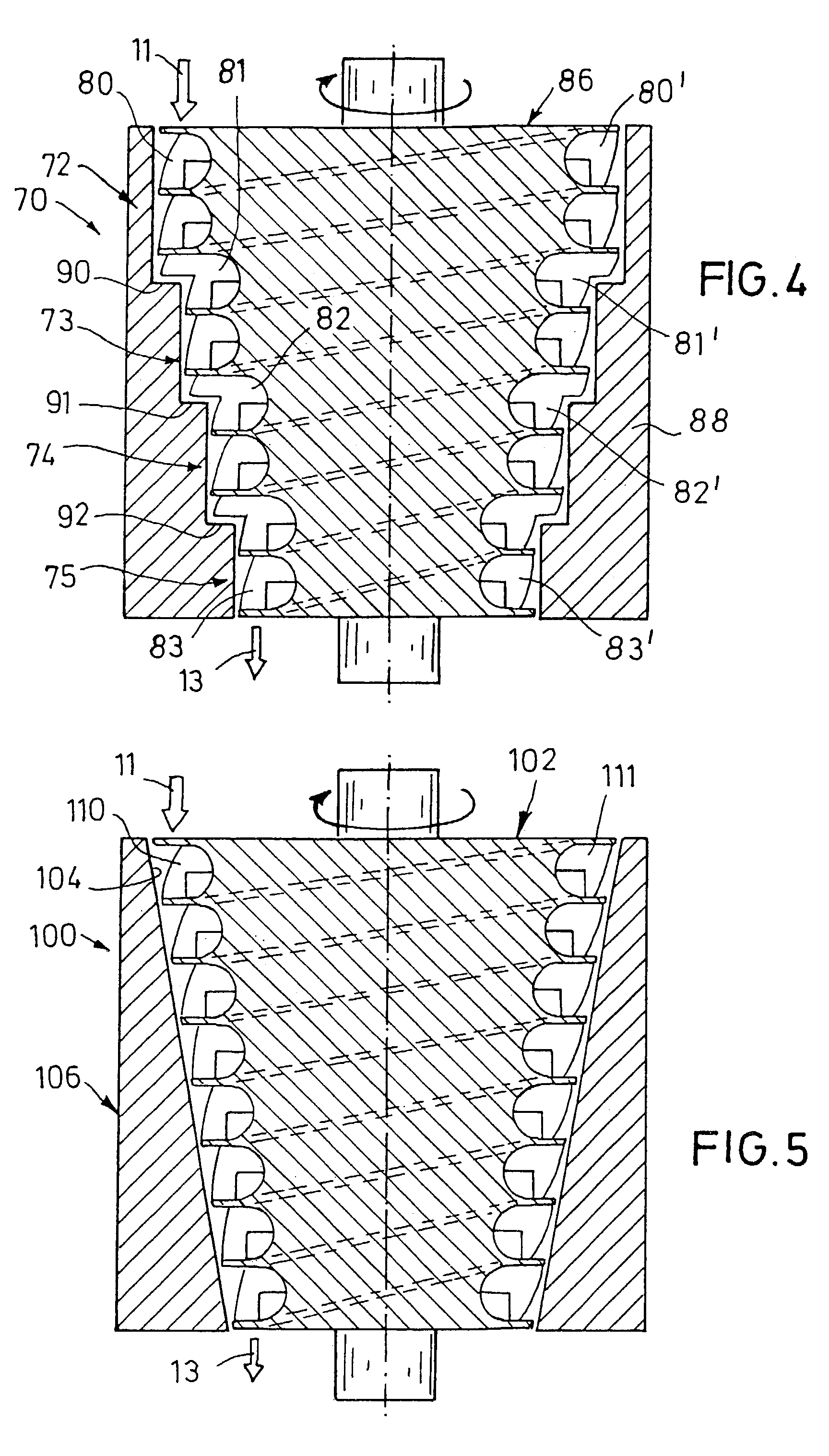Pump embodied as a side channel pump
a side channel pump and pump body technology, applied in the direction of propellers, propulsive elements, water-acting propulsive elements, etc., can solve the problems of limited suction capacity and compression ratio, heating and noise, and reduce noise emission, improve compression, and high compression of the pump
- Summary
- Abstract
- Description
- Claims
- Application Information
AI Technical Summary
Benefits of technology
Problems solved by technology
Method used
Image
Examples
first embodiment
[0040]In FIG. 1, a pump 10 which is a side channel pump, for delivering a fluid, and preferably for delivering a gas, is illustrated. The pump 10 serves to produce a vacuum on a suction side 11 and to compress the fluid into medium vacuum or rough vacuum on a pressure side 13.
[0041]The side channel vacuum pump 10 is substantially formed by a stator 14 forming a fixed housing 12 and a driven rotor 16 in the stator housing 12. The rotor 16 is driven by an electric motor (not shown) by which the rotor 16 can be rotated at up to 80,000 revolutions / minute. The rotor 16 and the stator housing 12 are preferably made of metal, but may also be made of ceramics, be made of plastics or of a material coated with plastics. The operation of the vacuum pump 10 is preferably lubricant-free so that a contamination of the pumped fluid is avoided.
[0042]From the suction side 11 of the vacuum pump 10, the fluid flows through a fluid inlet 48 into the stator housing 12 at the one end face of the rotor 16...
second embodiment
[0052]In FIG. 4, a double-lead side channel pump 70 is illustrated, where four steps 72, 73, 74, 75 with pump channels 80–83, 80′–83′ of different diameters are provided. Each step 72–75 comprises two parallel pump channels 80, 80′; 81, 81′; 82, 82′; 83, 83′, by which the suction capacity of the pump 70 is doubled in comparison with single-lead pumps. A rotor 86 as well as the a stator housing wall 88 are configured so as to be stepped such that the radius of the pump channels 80–83 respectively decreases to the pressure side 13 from step to step, whereas the cross-sectional area of the pump channels 80 B 83, 80′–83′ respectively remains the same. The height of each radial step 90, 91, 92 amounts to about one third of the radial height of a pump channel 80–83, 80′–83′. By limiting the height of the radial step to half of the radial pump channel height at maximum, the screw thread-like course of the pump channel is largely preserved in the region of the radial steps 90–92 as well. In...
third embodiment
[0053]In FIG. 5, a side channel pump 100 is illustrated where a rotor 102 as well as a housing wall inside 104 of a stator 106 are configured so as to conically taper from the suction side 11 to the pressure side 13. The rotor 102 comprises two pump channels 110 and 111 arranged next to each other on the rotor outside in a helical manner. The radial height of the two parallel pump channels 110, 111 is constant over the entire length of the pump channels 110, 111. By the tapering the rotor 102 and the stator 106 towards the pressure side, friction between rotor 102 and stator 106 is reduced.
PUM
 Login to View More
Login to View More Abstract
Description
Claims
Application Information
 Login to View More
Login to View More - R&D
- Intellectual Property
- Life Sciences
- Materials
- Tech Scout
- Unparalleled Data Quality
- Higher Quality Content
- 60% Fewer Hallucinations
Browse by: Latest US Patents, China's latest patents, Technical Efficacy Thesaurus, Application Domain, Technology Topic, Popular Technical Reports.
© 2025 PatSnap. All rights reserved.Legal|Privacy policy|Modern Slavery Act Transparency Statement|Sitemap|About US| Contact US: help@patsnap.com



